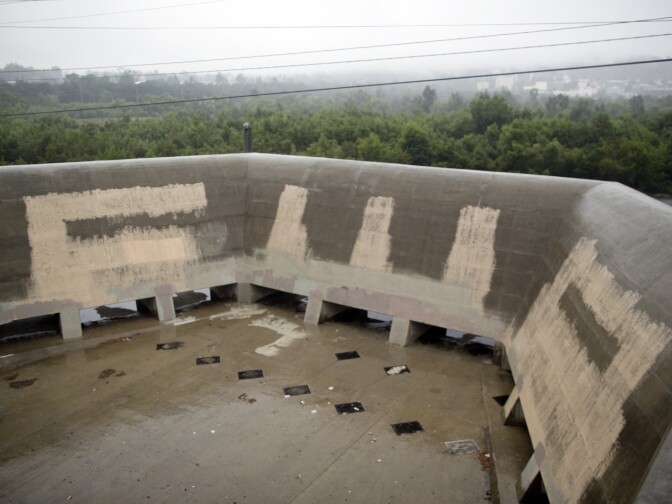With our free press under threat and federal funding for public media gone, your support matters more than ever. Help keep the LAist newsroom strong, become a monthly member or increase your support today.
El Niño: Hundreds of homes could flood along Arroyo Seco Channel in biggest storm
Hundreds of homes along the Arroyo Seco channel are at risk of flooding if this winter's expected El Niño weather system brings unusually heavy rains. But those residents are not required to buy flood insurance, and some said they were unaware their homes could be at risk.
The flood peril comes from the high level of sediment in the reservoir behind the Devil's Gate Dam in Pasadena. The dam, visible from the 210 Freeway near the Oak Grove Drive off-ramp, is more than half full, meaning its capacity to hold water and debris in a major storm is limited.
The scenario under which some 500 homes and parcels could flood is rare, but urgent enough that Los Angeles County Flood Control officials commissioned a report mapping the areas along the Arroyo that could flood.
If the 32-square-mile watershed that drains into Devil's Gate Dam got the kind of storm that has a 2 percent probability of occurring in any given year, that would fill the dam with sediment and clog its water release gates and valves.
"Then with another storm following that of that size, it could create that flooding scenario downstream, said Chris Stone, deputy director of the County Flood Control District.
If county dam operators lose control of the amount of water and sediment flowing into the Arroyo Seco Channel, the water could overtop the channel walls by two to 10 feet, mainly at places where the channel curves between Pasadena and the channel's confluence with the Los Angeles River. It could also flood parts of the 110 freeway.
The sediment has been building up since the dam's construction in 1920, but about one-quarter of it flowed in with rains that followed the 2009 Station Fire that burned much of the San Gabriel Mountains watershed that drains into the dam basin.
One of the neighborhoods at risk of floor is a small slice of Pasadena's Busch Gardens neighborhood. It was part of a botanical park created by beer magnate Adolphus Busch a century ago. Today, it's a quiet subdivision of million-dollar homes.
Lillian Lee bought her home in August, attracted by the neighborhood's trees and solitude. It's very close to to the popular Arroyo hiking path alongside the concrete channel. The graceful arch of the San Rafael Ave. bridge is just behind the house.
The county's flood risk map shows her single-story 1950s ranch-style home under a layer of blue ink. Hers is one of seven homes in Pasadena that could flood in a 50-year storm.
"It shows that I am in a flood zone, a possible flood zone," Lee said.
She signed a hazard zone declaration about her property, but didn't give the dam much thought.
"I read that it was dry. There's nothing in it," she said. "It would have been nice to know this before I bought the house and if the county had made it a priority to let potential buyers know, but I certainly did not know this."
The channel could overflow by two feet near her home, spreading water some 200 feet beyond the channel's walls. Her slab-foundation home would be flooded.
This season's first big storm in mid-September dropped more than two inches of rain on the 32-square-mile watershed that drains into Devil's Gate Dam and the Arroyo Seco. It was a far less intense storm than the one the county has been worried about, yet it set roiling waters flowing up the face of the dam.
"Knowing that a large storm could come in at any time, fill this up... you have no flood control protection downstream. [That] concerns us," Stone said.
Farther down the Arroyo, homes in Highland Park are also in the potential flood zone. The neighborhood close to the York Boulevard off-ramp of the 110 freeway has a concentration of homes at risk.
Salvador Castillo found his home on the county's flood risk map in the middle of the blue inundation zone.
"Chestnut, donde esta la Chestnut, Oh, aqui es La Chestnut," he said.
His home on Chestnut Avenue is not insured against flood.
"Yes, it's a risk, but there's no insurance to cover it," he said in Spanish.
His 29-year investment in his tiny, well-kept home would be wiped out by a flood, and he says he'd have no way to replace it.
Despite this risk to so many homes, flood insurance is not required by the federal government in these areas. That's because the county sees the danger as temporary, one that can be remedied by sediment removal, said Kerjon Lee, a spokesman for the county Flood Control District.
According to a plan approved by the Board of Supervisors last year, the county wants to take out 2.4 million cubic yards of sediment from behind the dam over five years. But community opposition to this large-scale sediment removal plan has stalled the work until at least next year, after the expected rainy El Niño winter.
Tim Brick heads up the Arroyo Seco Foundation, which sued the county to scale back the sediment removal. It wants only 1.1 million to 1.4 million cubic yards removed. That's about half as much as the county wants hauled out. The foundation also wants the work to spread out over several more years than the county plan. That would mean fewer trucks carrying dirt, less dust, and fewer trees removed from the Hahamongna Watershed Park, the large recreation area behind the dam used by cyclists, runners, hikers, equestrians and others.
"They exaggerate the threat," Brick said. "We're not against sediment removal. We're for a sensible slow program that will minimize the impacts of their program."
He said his group's challenge of the sediment removal plan is not to blame for the heightened risk of flooding to downstream communities. That burden falls on the county, Brick said.
"They built this inadequate flood channel. If it overflows it's because the system is inadequate," Brick said.
His group says county should have been removing sediment on a routine basis over the years and not let it grow into the problem it's become.
"The problem isn't our opposition to their removing sediment, the problem is that they have an inadequate system that they're not managing properly," Brick said.
The lawsuit over sediment removal is unlikely to be settled before next year. And nothing more can be done to remove more sediment this year, county officials say.
Correction: An earlier version of this story said Los Angeles County has not required flood insurance on homes near the Arroyo Seco. Flood insurance requirements are set by the federal government.
Arroyo Seco flood zones
Maps of possible flood zones along the Arroyo Seco start on page 21 (indicated as 13 in the page footer) of the following document.



























